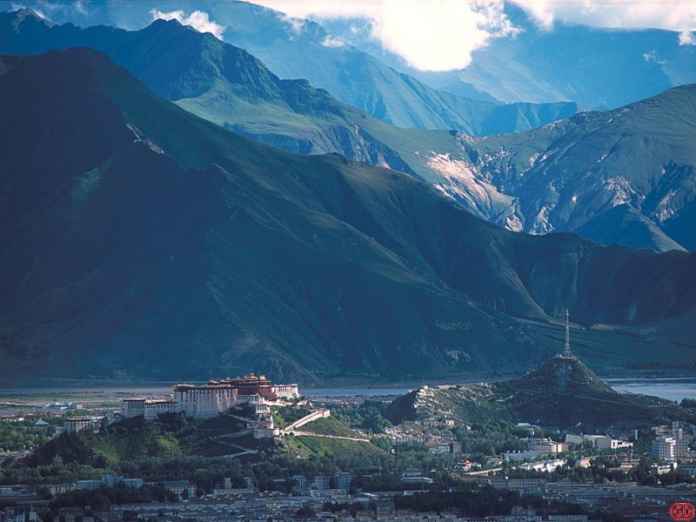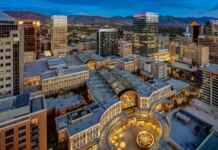Lhasa, it is rightly one of the most featured and dreamt-about cities in the world. Lhasa means “Land of the Gods”, it is the heart of Tibet. Over 1,300 years old, it sits in a valley right next to the Lhasa River. Its Prefecture covers an area of close to 30,000 km2 (12,000 sq mi) and it is the capital of the Tibet autonomous region in China. Differing from the inland cities and other places in Tibet, Lhasa is unique with an allure all of its own. In the Tibetan language, Lhasa means the Holy Land or the Buddha Land. It is the center of Tibet’s politics, economy and culture.
Located at the bottom of a small basin surrounded by the Himalaya Mountains, Lhasa has an elevation of about 3,600 m (11,800 ft) and lies in the center of the Tibetan Plateau with the surrounding mountains rising to 5,500 m (18,000 ft). The air only contains 68% of the oxygen compared to sea level. The city enjoys nearly 3,000 hours of sunlight annually and is thus sometimes called the “sunlit city” by Tibetans.
Attractions of Lhasa
Jokhang Temple: It was constructed in 7th century AD the temple has been enlarged many times over the centuries and now also houses statues of King Songtsan Gambo and his two famous foreign brides.
Potala Palace: The palace was rebuilt by the Fifth Dalai Lama in three years, while the Thirteenth Dalai Lama extended and repaired it into what it is now. With over 1 000 rooms, the Potala contained the living quarters of the Dalai Lamas while they lived, and their sumptuous golden tombs when they died. Potala Palace also houses great amounts of rare cultural relics including the gold hand-written Buddhist scriptures, valuable gifts from the Chinese emperors and a lot of priceless antiques.
Barkhor Street market: It is the oldest street in a very traditional style in Tibet around the Jokhang Temple in the center of the old section of Lhasa. Barkhor Street is one of the most important religious paths along which pilgrims walk around Jokhang Temple while turning prayer wheels in their hands through centuries.
How to reach there?
Airlines
50 km from Lhasa there is Lhasa Gonggar Airport and it takes an hour to reach the city centre. Flights from these places arrive and depart from Lhasa Gonggar Airport:
- Beijing
- Chengdu
- Chongqing
- Guangzhou
- Kunming
- Qamdo
- Shanghai
- Xi’an
- Xining
- Zhongdian
Trains
The Qinghai-Tibet Railway stretches from the ancient city of Xining in Qingha Province to Lhasa. This stretch holds claim to being the highest railway ever constructed. It traverses unbelievably harsh terrain and utilized some of the most complex technology available to overcome particularly difficult constructional challenges, a combination of factors virtually never encountered in the history of railroads, either in China, or across the world.
- T27/8 to/from Beijing (West) – Lhasa – takes about 46 hours, every day
- T22/23/24/21 to/from Chengdu – Lhasa – takes about 45 hours, every other day
- T222/223/224/221 to/from Chongqing – Lhasa – takes about 47 hours, every other day
- T164/5 T166/3 to/from Shanghai – Lhasa – takes about 49 hours, every day
- T262/4 to/from Guangzhou – Lhasa – takes about 57 hours, every other day
- K917/K918 to/from Lanzhou – Lhasa – takes about 27 hours, every day
- K9801/K9802 to/from Xining – Lhasa – takes about 23 hours, every day
How to roam around?
Taking mini-bus is the cheapest way to get around in the city. The fare is 2 Yuan no matter how far you go. The private run mini-bus or jeep follows certain fixed route and the fare is also 2 Yuan. Most of them have a stop at the Tibetan Hospital (in the Jokhang Square). Taking a taxi may cost you 10 Yuan no matter where you go in the city. But if you want to go out of town, you’d better negotiate with the driver over the price. Riding a tricycle is a good way to enjoy the appearance of the city. A tricycle usually takes two people and the price varies from 4 Yuan to 7 Yuan.
Legal cautions
Enter with a valid passport,visas must be obtained prior to departure. Transit visas are not required for travellers who are on continuing international flights, who hold tickets on connecting flights, or who will remain at the airport for no more than 24 hours while awaiting transit.
Smuggling is a major offence. There are absolute prohibitions against arms, drugs, and plant or animal products considered infested with disease or pests. There are also restrictions on the entry of printed matter, film, photos, videotapes and CDs considered detrimental to the interests of China.
Beware, con artists are always around and they specially target tourist.














